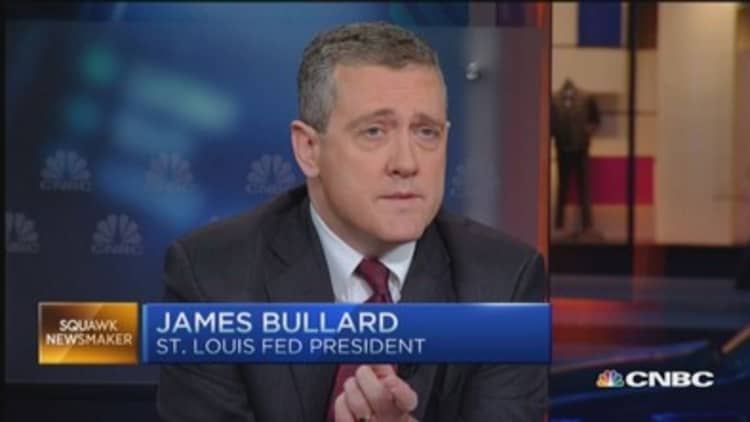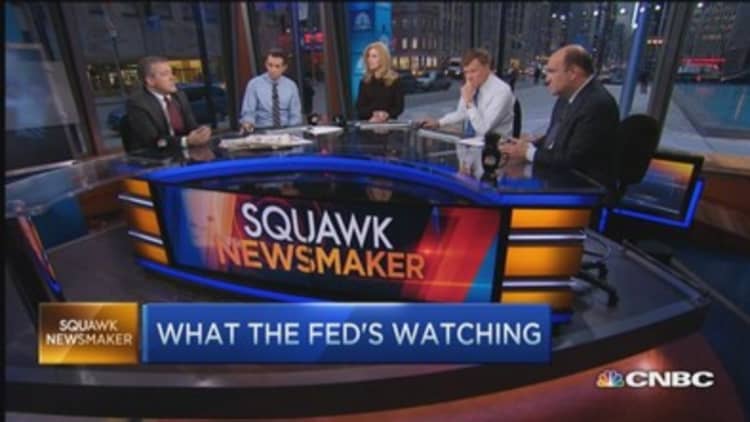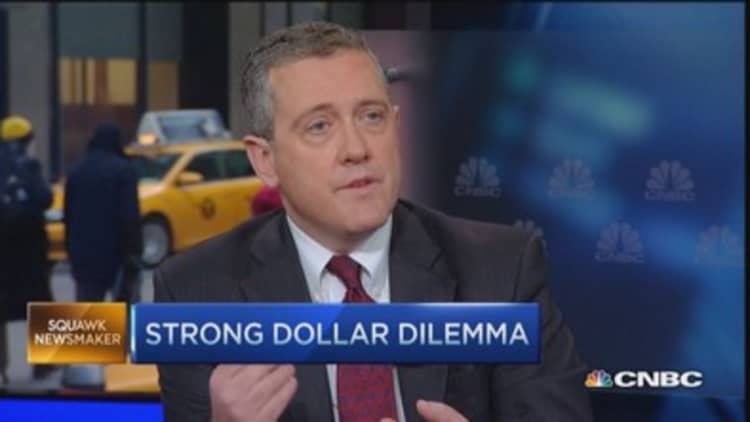



St. Louis Fed President James Bullard told CNBC on Thursday the word "patient" should come out of the policy statement in March to give options for raising interest rates this summer.
"There's too much focus about the first move," he said. "It's really the path of rates that matter."
Bullard, who's generally hawkish, called possible rate hikes "the normalization process," as he expects the unemployment rate to fall below 5 percent in the second half of the year and overall economic growth at 3 percent for 2015.
Read MoreThe US isn't asstrong as you think: O'Neill
"I'd be for starting a little bit earlier on the normalization process. It's not tightening," he said in a "Squawk Box" interview. "It's still going to be a very accommodative policy even if we move off zero."
He characterized the policy rate as 375-400 basis points below normal.
"These labor markets are improving so rapidly," Bullard said. "If you haven't even come off zero and the unemployment rate has come down below 5 percent, that seems like a bit little extreme to me."
The U.S. economy added a better-than-expected 257,000 jobs for last month, but the unemployment rate edged higher to 5.7 percent.
Bullard, a nonvoting member of the policymaking Federal Open Market Committee, was complimentary of Fed Chair Janet Yellen's performance this week on Capitol Hill, where she told lawmakers there would be no rate hike for "at least the next couple of FOMC meetings."
Inflation and economic growth
On the inflation side, he acknowledged price increases are below the central bank's 2 percent target, but he said "a lot of that" is due to the collapse in oil over the past year.
The government said Thursday that consumer prices fell 0.7 percent in January, a tad more than estimates—while the core rate, excluding food and energy costs, increased 0.2 percent.
"The core being a little hotter than expected, I think, will bolster confidence a little be that inflation is going to go back toward target," Bullard said.
While predicting 3 percent gross domestic product growth this year, he also said investors need to start thinking about growth differently. "It used to be that if you're growing at 3 percent, you were growing at trend. But now if you're growing at 3 percent, you're growing a percentage point above trend."
In the fourth quarter, GDP expanded at a 2.6 percent annual pace, after the third quarter's strong 5 percent growth rate.
Answering critics who say wages should be growing faster in this strengthening economy, Bullard said, "If you want more wage gains in the U.S., you need more productivity growth. That's our problem in the U.S., low productivity."
The strong dollar
Many multinational companies have been warning about future quarterly results because of the strong dollar.
Bullard dismissed that excuse. "We've grown at these dollar levels before. I don't see why we can't do it now."
The dollar index—measuring the greenback's strength against a trade-weighted basket of six major currencies—has increased more than 17 percent in the past year.
But Bullard argued that the dollar effects on the overall economy are marginal.
"We are going to pursue the best monetary policy for the U.S., and the dollar is going to go where it's going to go," he continued, "because that depends on what the other guys are doing. And in the last year, it has depended a lot on what the ECB is doing."
While the Fed ended its massive bond-buying in the fall and now considers rate hikes, the European Central Bank last month announced its own 1.2 trillion bond purchase program.


